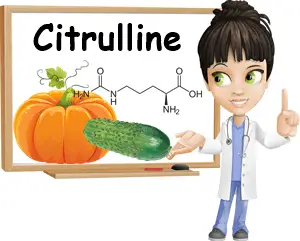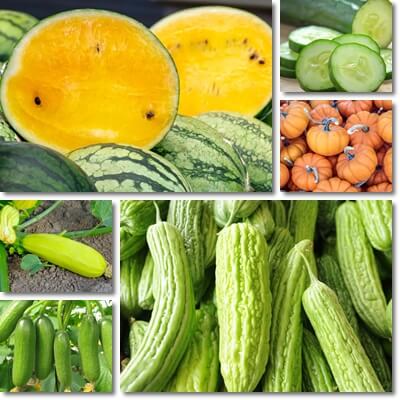Citrulline is an amino acid found naturally in watermelon flesh, the white part of watermelon and watermelon rind, among other foods.
While it is a non-essential amino acid, it is an important biologically active component with direct effects on multiple systems and organs include the heart and muscles, the vascular system, the immune system, as well as the digestive and nervous systems.
The benefits of citrulline are varied and include better blood circulation and lower blood pressure numbers, good muscle and digestive function and immuno-modulating effects.
What is citrulline?
Citrulline is a non-essential but highly biologically active amino acid. As a non-essential amino acid, it is not required from the diet because it is produced in the human body (e.g. from arginine during nitric oxide production and from trichohyalin in hair follicles).
But citrulline is also available in the diet from bitter gourd and other gourds, pumpkin, cucumber and especially watermelon. Getting enough citrulline boosts health and is especially good for circulation, muscle function and exercise performance.

Best Citrulline food sources
- Yellow fleshed watermelon
- Orange fleshed watermelon
- Red fleshed watermelon
Note: watermelon varieties grown in arid regions appear to be higher in citrulline than domesticated watermelon varieties. - Watermelon juice
- Gourds and squashes, both edible and decorative varieties
- Winter squashes: pumpkin and pumpkin leaves
- Summer squashes: zucchini, courgette, marrow
- Muskmelons: cantaloupe, honeydew melon, Christmas melon, Persian melon
- Cucumber and cucumber juice
- Bitter gourd, bitter squash or bitter melon
Note: Of all watermelon colors, yellow fleshed watermelon is highest in citrulline, followed by orange fleshed watermelon and then red fleshed watermelon.
Note: According to research, seedless Hazera SW1 and Solid Gold, and seeded Summer Gold varieties of watermelon as well as Crimson Sweet had the best content of citrulline among varieties studied with 28 mg/g dry weight.
Note: Watermelon rind is a natural source of citrulline. Both the green and white part of the watermelon rind contain citrulline in good amounts. But while the outer green skin needs cooking to render it edible, you can eat the white part as it is and get more citrulline in your diet.

12 Benefits of citrulline
1-Raises plasma arginine levels
Arginine is synthesized from citrulline in the small intestine and kidneys. Arginine is needed for wound healing, ammonia detoxification and for the synthesis of nitric oxide for blood pressure regulation, among other benefits. Arginine is a conditionally essential amino acid which means that, while it’s produced in the body, there are instances of increased demands when it’s also required from the diet (e.g. physiological stress, injuries, disease). Getting enough citrulline in your diet sustains arginine production and associated benefits for health.
2-Circulatory benefits
Citrulline circulating in the digestive tract triggers the production of the amino acid arginine. The presence of sufficient arginine in the circulatory system is a biological marker of cardiovascular health, indicating the inner lining of blood vessels is healthy. Arginine is also needed for the synthesis of nitric oxide which functions as a cell messenger for the circulatory system, initiating vasodilation which allows for blood pressure numbers to drop.
3-Vasodilating properties
Nitric oxide produced from arginine which is produced from citrulline acts as a cell messenger and signals the smooth muscles of blood vessels to relax and dilate. Vasodilation causes high blood pressure numbers to drop.
4-Vasoprotective properties
The presence of sufficient amounts of the amino acid arginine in the blood is considered an indicator of vascular health, designating a state of good health of the endothelium, the inner lining of blood vessels. A healthy endothelium supports cardiovascular health. Getting enough citrulline ensures enough arginine is produced for good vascular health.
5-Anti-hypertensive benefits
Citrulline indirectly contributes to cardiovascular health by supporting the production of arginine needed for the production of nitric oxide. Nitric oxide exerts vasodilating properties, signaling to blood vessel muscles to relax which causes dilation of the blood vessels and improved blood flow, reducing the pressure exerted by the blood against blood vessel walls. This results in a drop in blood pressure numbers and anti-hypertensive benefits.
6-Supports muscle function
Citrulline supports muscle function indirectly, via production of arginine needed for the synthesis of nitric oxide. Nitric oxide initiates vasodilation, causing blood vessels to relax and dilate. This results in better blood flow (and a drop in blood pressure numbers). Better blood flow means better muscle oxygenation and supports normal muscle function including during exercise.
7-Benefits for exercise performance
Nitric oxide produced from arginine which is produced from citrulline is a cell messenger. It triggers vasodilation, the relaxation and dilation of blood vessels. Vasodilation improves blood flow and subsequently also muscle oxygenation, supporting muscle function during exercise. Another benefit of nitric oxide is it causes a drop in blood pressure which further favors exercise performance, reducing symptoms such as feeling out of breath, the lump in throat sensation experienced during intensive exercise and even angina or chest pain. In animal studies, citrulline malate supplementation increased resistance to muscle fatigue.
8-Benefits for men
Improved blood flow and better oxygenation, as well as good overall cardio-vascular health all contribute to improved endurance and better stamina in men.
9-Benefits for sickle cell anemia
Emerging research suggests there may be a benefit to citrulline supplementation for sickle cell anemia, a type of blood disease caused by deformities to oxygen-transporting red blood cells. Supplementation with L-citrulline in children and adolescents with sickle cell disease resulted in improvement of symptoms, raised plasma arginine levels, and reduced elevated total leukocyte and segmented neutrophil counts to within normal limits (source).
10-Antioxidant benefits
Citrulline is known to be both an amino acid and an antioxidant. As an antioxidant, citrulline scavenges free radicals and helps combat oxidative stress and associated cell damage and inflammation.
11-Potential benefits for intestinal functionality
The bulk of circulating citrulline is located in the digestive tract, more exactly, in the small intestine, a major site of arginine synthesis. Because of this, citrulline is considered a biological marker for intestinal health and intestinal functionality, just as arginine is considered a biological marker for endothelial health.
12Immuno-modulating properties
One of the functions of citrulline is modulating the immune system response. For one, citrulline is a biological marker for intestinal functionality and health, the intestinal tract being one of the most active components of the immune system and site of presence of immune system tissue. Also, citrullination, the conversion of arginine back into citrulline, is part of the normal immune system response. Citrulline supports the production of arginine which functions as a wound healing agent and is actively part of the immune system response.
Side effects of citrulline
There are really no side effects associated with consumption of citrulline from food sources, given that intake of the amino acid from food is reasonable. Citrulline taken as a dietary supplement is relatively safe, but can be a source of side effects when combined with certain medication. The rule of thumb is to avoid taking citrulline supplements if you are also taking medication for the same conditions citrulline supplements are meant to help with, for example: high blood pressure medication, medication targeted at improving blood flow and treating angina.
